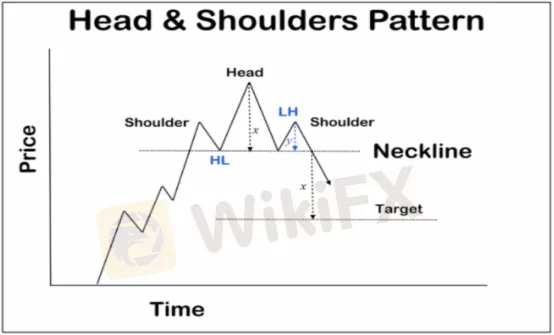简体中文
繁體中文
English
Pусский
日本語
ภาษาไทย
Tiếng Việt
Bahasa Indonesia
Español
हिन्दी
Filippiiniläinen
Français
Deutsch
Português
Türkçe
한국어
العربية
Pattern for the Head and Shoulders
Abstract:There are a few trading patterns that the technical trader seems to return to time and time again. The "head and shoulders pattern" is without a doubt one of the most popular. In fact, some traders would exclusively trade this pattern, but there are a few factors to take in mind before using it, as with everything else.
There are a few trading patterns that the technical trader seems to return to time and time again. The “head and shoulders pattern” is without a doubt one of the most popular. In fact, some traders would exclusively trade this pattern, but there are a few factors to take in mind before using it, as with everything else.

Defining the pattern is the first step.
The first step is to figure out what pattern we're dealing with. The left shoulder, the head, and the right shoulder are the three sections of the head and shoulders pattern. It's a pattern in which a high arises, then a retreat, a higher high, and finally a low or high. In other words, the right shoulder, the third section of the pattern, is a lower height from the head.
It is not necessary for all head and shoulders patterns to be negative.
There is an inverse pattern, as is the case with many technical patterns. This is essentially a sequence of three lows, beginning with a rebound back to the upside on the left hand shoulder, then a break down to create the head, a bounce back to the upside, and finally a “higher low” producing the third shoulder. It's a “upside down head and shoulders design,” to put it simply. This indicates that the selling are losing steam, and the market might be poised for a strong rally. Take a look at the graph below to understand how this works in reverse. It should be obvious that it is the exact same thing, only inverted.
Head and shoulders patterns don't have to be negative all of the time.
An inverse pattern exists, as it does with many technical patterns. This is merely a sequence of three lows, beginning with a rebound back to the upside on the left hand shoulder, then a break down to create the head, a bounce back to the upside, and finally a “higher low” producing the third shoulder. It's a “inverted head and shoulders pattern,” to put it simply. This indicates that the sellers' impetus is fading, and the market may be poised for a strong rally. See how this works in an inverted pattern in the graphic below. It's the same thing, but inverted.
Remember, if you require other people to go along with you, simplicity is one of the features of a strong trading method. These clear patterns are beneficial since the rest of the market can be pushed in the same direction as you.

Disclaimer:
The views in this article only represent the author's personal views, and do not constitute investment advice on this platform. This platform does not guarantee the accuracy, completeness and timeliness of the information in the article, and will not be liable for any loss caused by the use of or reliance on the information in the article.
Read more

Should You Beware of Forex Trading Gurus?
Know the reality behind forex trading gurus, examining their deceptive tactics, inflated promises, and the risks associated with trusting them for financial advice.

Why More People Are Trading Online Today?
Discover why online trading is booming with tech, AI, and a push for financial freedom. From stocks to crypto, it’s a thrilling hustle for all.

High Return Traps? WikiFX’s Complete Scam-Busting Handbook to Avoid Financial Fraud!
Financial scams are evolving faster than ever, and fraudsters are getting more creative in luring victims into traps. Whether it’s promising high returns or leveraging authority to build trust, scammers continuously innovate new ways to trick investors. From clone firms to cold calling schemes, it’s essential to understand how these scams work to protect your hard-earned money. This comprehensive guide by WikiFX will help you recognize and avoid common financial scams.

Do This ONE Thing to Transform Your Trading Performance Forever
The story is all too familiar. You start trading with high hopes, make some quick profits, and feel like you've finally cracked the code. But then, just as fast as your gains came, they disappear. Your account balance dwindles, and soon you’re left wondering what went wrong. Worse still, fear and confusion creep in, making every new trade a stressful gamble rather than a calculated decision. If this cycle sounds familiar, you’re not alone.
WikiFX Broker
Latest News
Interactive Brokers Launches Forecast Contracts in Canada for Market Predictions
Authorities Alert: MAS Impersonation Scam Hits Singapore
INFINOX Partners with Acelerador Racing for Porsche Cup Brazil 2025
Billboard Warns of Crypto Scams Using Its Name – Stay Alert!
The Impact of Interest Rate Decisions on the Forex Market
STARTRADER Spreads Kindness Through Ramadan Campaign
How a Housewife Lost RM288,235 in a Facebook Investment Scam
Rising WhatsApp Scams Highlight Need for Stronger User Protections
A Trader’s Worst Mistake: Overlooking Broker Reviews Could Cost You Everything
The Daily Habits of a Profitable Trader
Currency Calculator







